Cylinder Vessel with Image of Seated Lord and Attendants at Court
We don’t know the name of the artist who made this vessel, but it’s apparent that they were very skilled. The artist was able to give the human figures depicted on the vessel depth and substance, conveying individual personalities and even humor. A hieroglyphic text encircles the top of the vessel and occurs within the painted scene. It took great skill to paint both the figures and hieroglyphs with such control.
The glyphic text indicates that this vessel was probably made in what is now Guatemala. Vessels like this were made from local clays and other materials that were added for strength. Before firing the vessel, the artist covered it with a white or orange slip, a mixture of clay and water, to serve as background color. The artist then painted images and designs onto the polished surface with mineral-pigmented slips. The last step was to fire the vessel in an open pit.
The inscription on this vessel tells us it was crafted for the father of the central, seated lord and was used for drinking cacao or chocolate. Painted on the thin-walled cylindrical vessel is a scene of palace life that involves a tribute payment to the lord. Goods on display include two circular fans woven of reed or palm leaf, several stacks of textiles, and three large bags of cacao or chocolate beans. Cacao beans were a gourmet food item and could also be used as a form of money. While the assembled men participate openly in the event, two women (seated on the right) are shielded from public view. Probably members of the noble household, they appear to listen to the discussion with interest.
Life in noble Maya courts was both luxurious and sophisticated. Maya cities incorporated elaborate stone and stucco architecture, carved ruler portraits on free-standing stone slabs, and painted large-scale mural scenes. Elegant, multi-colored painted ceramics were owned and used by the elite.
Details
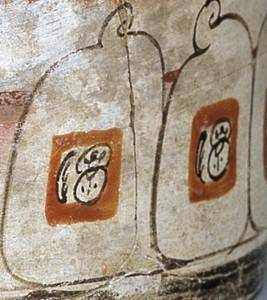
Bags of Cacao Beans
The Maya used cacao as the basis for chocolate drinks and as a form of currency. Three bags of cacao beans are depicted on the step below the principle lord and the youths, probably sons, who sit next to him.
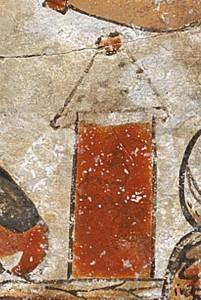
Cacao Vessel
Directly in front of the principle lord is a tall cylindrical vessel, most likely filled with a chocolate beverage.
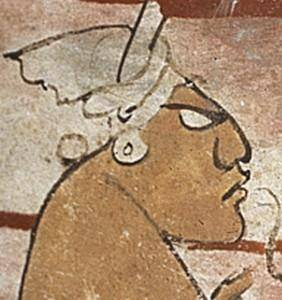
Sloping Forehead
A sloping forehead and elongated head shape were signs of beauty among the Maya elite. Sometimes, an infant’s still soft head was bound between boards to achieve the desired head shape, emphasizing a smooth unbroken line between the nose and the forehead.
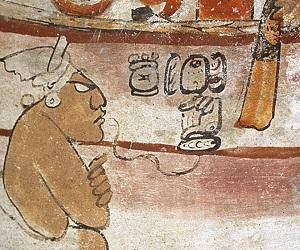
Pink Wash
A delicate pink wash shades the inscriptions and the scene. The colored wash provides the vessel with a distinct look.

Setting
The artist has arranged the ten figures in an interior space that features a two-level platform, curtains, and woven mats.
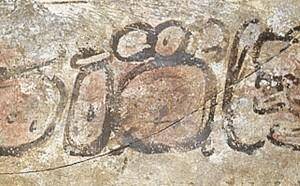
Hieroglyphs
The painted inscription records the name of the large central figure, who is the ruler of the court (Nabnal K’inich Lakam). It also names his father (Yuknoom K’awiil), from the site of Rio Azul in present-day Guatemala. The inscription also identifies the vessel as a drinking vessel for cacao or chocolate.
More Resources
Find an illustrated and annotated version of the painting on Vase with Palace Scene here.
Websites
Children's Guide: Courtly Art of the Ancient Maya
Written by Carla Brenner and the National Gallery of Art, this online guide from a 2004 exhibition provides basic background information about the Maya, with a section on Maya vases used for drinking chocolate, including a recipe. Here you can also find a few short activities and further resources for children, such as books and websites.
Living Maya Time
An interactive website from the Smithsonian Museum of the American Indian featuring Mayan astronomy and agriculture.
The British Museum Explore/World Cultures: Maya
A brief overview of the Maya.
Foundation for the Advancement of Mesoamerican Studies, Inc. (FAMSI)
This site provides a large variety of online resources and databases, including the Maya Vase Database.
MESOWEB
A website with numerous resources and online articles related to Mesoamerica.
NOVA: Cracking the Maya Code
From PBS, this NOVA video about deciphering Mayan hieroglyphics can be viewed online, and is available on DVD and video.
DIG! The Maya Project
Kids are the archaeologists in this interactive game from the Dallas Museum of Art. They can "intern" with an archaeologist, dig for Mayan objects, record their finds in a journal, and play games. Recommended for ages 10 and up.
Books
Coe, Michael D. Lords of the Underworld: Masterpieces of Classic Maya Ceramics. Princeton, NJ: Art Museum, Princeton University, distributed by Princeton University Press, 1978.
Several examples of Maya pottery including descriptions, images, and rollouts.
Coe, Michael, and Justin Kerr. The Art of the Maya Scribe. New York: Harry N. Abrams, Inc. 1997.
The first chapter, "The Maya Universe," is helpful in conceptualizing the Maya world.
Driess, Meredith L. Chocolate: Pathway to the Gods. Tucson: University of Arizona Press, 2008.
A history of the significant role of chocolate, and its social, political, and ritual functions throughout Mesoamerica.
Kerr, Justin. The Maya Vase Book: A Corpus of Rollout Photographs of Maya Vases. New York, NY: Kerr Associates, 1989-2001.
A collection of essays related to Mayan ceramics, as well as numerous rollouts.
Miller, Mary Ellen. Maya Art and Architecture. New York: Thames & Hudson, 1999.
See chapter 9 of this book for a discussion of Maya ceramics.
Reents-Budet, Dorie. Painting the Maya Universe: Royal Ceramics of the Classic Period, Durham, NC: Duke University Press, 1994.
Several examples of Maya ceramics as well as information related to the art form.
Children's Books
Laurie Coulter. Secrets in Stone: All about Maya Hieroglyphs. Boston: Little, Brown and Company, 2001.
An aid in understanding the complexity of Maya hieroglyphics. For grades 3-6.
Rachel Crandell. Hands of the Maya: Villagers at Work and Play. New York: Henry Holt and Company, 2002.
A view of Maya village life, for Kindergarden – 4th grade students.
Peter Lourie. The Mystery of the Maya: Uncovering the Lost City of Palenque. Honesdale, PA: Boyds Mill Press, 2001.
For students in grades 4 - 8, this is a photographic exploration of the archaeological site of Palenque.
Linda Lowery. The Chocolate Tree: A Mayan Folktale. Minneapolis, MN: Millbrook Press, 2009.
A folktale for kids ages 4-8 about how chocolate came to be.
Funding for object education resources provided by a grant from the Morgridge Family Foundation. Additional funding provided by the William Randolph Hearst Endowment for Education Programs, and Xcel Energy Foundation. We thank our colleagues at the University of Denver Morgridge College of Education.
The images on this page are intended for classroom use only and may not be reproduced for other reasons without the permission of the Denver Art Museum. This object may not currently be on display at the museum.
